
Fontanels: Issues and Setons Page Menu: 1 2 3 4 5 6 <<First
Fontanels: Issues and Setons in the Golden Age of Piracy, Page 6
Health Problems Requiring a Fontanel
“Issues are made in many Infirmities and Diseases; especially in great pains of the Head, in several Distempers of the Eyes and Teeth, Noise and Deafness of the Ears, the Gout, old Ulcers, Fistula’s and in all manner of copious Defluxions of Humours to what part soever; for tho’ they do not always free the Patient from his Distemper, yet they give some ease, by carrying of a great Mass of Acrid and Acid Humours. They are used also in Apoplexies, Falling Sickness, Dizziness of the Head, in tumified Legs, Ischiatick Pains, Lameness, and in several other Diseases, wherein if they have been of long continuance, they are very Beneficial.”(Matthias Gottfried Purmann, Chirurgia Curiousa, p. 305)
As Purmann's quote shows, fontanels enjoyed wide usage during the golden age of piracy. Their frequent utilization with a variety of similar humoral remedies can suggest that a medical practitioner was throwing anything and everything at some problems with the hope that one of them would work. However, they were also used for specific health problems in a more targeted way. More directed applications of fontanels are found in eye troubles, head wounds, abscesses and infected ulcers, swelling and infected tumors, fistulas-in-ano, convulsive twitching and wasting syndrome.
Health Problems Requiring a Fontanel: Humoral Treatments
The widest variety of fontanel use springs from humoral treatments. While it is true that the use of fontanels in nearly all illnesses was related to humors, in some cases they appeared to be just another of the many humor-altering treatments.
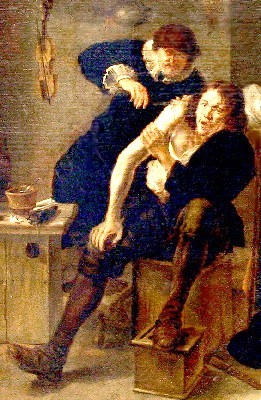
Artist: Gerrit Ludens
Schulteroperation in einer Baderstube (17thc.)
During his examination for his license to practice surgery in London, James Yonge was asked how to treat sciatica [irritation and pain in the spinal nerve]. "I told him the causes were various, many times scrophulous [from corrupted humors] &c. and that the remedies were to be accordingly [varied], that in general cautery, epecraticks [purgatives], fontanelles, internal anodines [pain relieving medicines], external corroborators [topical medicines] and nervous application were to be used."1 Although he left out bleeding and cupping, Yonge covered a lot of the various humoral treatments with his answer.
Cancerous tumors [cancerous then meaning rotted or pitted tumors, not the modern definition of abnormal cell growth in the body] brought out a litany of humoral treatments. Military surgeon Richard Wiseman advised he readers to dress and medicate the wound, while also "remembring to keep the Body soluble [loose and open all] the while by Clysters [enemas], and purges [emetics] or bleed as you see occasion. And if they [the patient] had no Fontanels before, make them some now: for though the Cure may seem successfull, yet if there be any evil quality in the Humours remaining the Ulcer will scarce cicatrize [heal over with a scar]."2
Wiseman elsewhere suggests eliminating the corroded skin with a cautery iron, "but if this cannot be effected, then endeavour

Artist: Georg Bartisch
Seton in the Neck (1583)
Palliation [relief from pain and similar symptoms] by such Medicaments as above have been proposed; and in case the Menstrua or Hæmorrhoids be stopt, bleed by Venæsection or by Leeches, and make Fontanels: for by such means many people live tolerably well who have Cancers ulcerated"3.
Another example of multiple humoral treatments that included fontanels occurred when a soldier's gun accidentally fired, causing his rammer to tear across his hand. Wiseman dressed the abrasion and performed the usual humoral treatments. However, the wound was bitten by rats as the soldier slept, so Wiseman brought it to suppuration using medicines to encourage infection and generate 'laudable' pus. "After I had cured them, I made him a Fontanel in that Arm, and bathed the member frequently, also cupped and scarified it; and afterwards applied Plaisters of Pitch, to stir up a heat in the Members."4
A variety of other health problems are mentioned in conjunction with fontanels and other humoral treatments. Naval surgeon John Atkins advised treating Lipothymia (a feeling of faintness) with blistering and fontanels on the shoulders.5 Wiseman uses fontanels in dislocations (often called luxations during this time) along with "corroborating Fomentations, Emplasters, [and] Epispasticks [blistering medicines]"6
1 James Yonge, The Journal of James Yonge [1647-1721] Plymouth Surgeon, p. 218;2 Richard Wiseman, Eight Chirurgicall Treatises, 3rd Edition, p. 104; 3 Wiseman, p. 105; 4 Richard Wiseman, Of Wounds, Severall Chirurgicall Treatises, p. 437-8; 5 John Atkins, The Navy Surgeon, p. 187; 5 Wiseman, Severall Chirurgicall Treatises, p. 483
Health Problems Requiring a Fontanel: Eye Troubles
Health problems with the eyes were frequently treated with both issues and setons during the golden age of piracy. While this was often part of a regiment of humoral treatments to relieve the eyes of unwanted humors, many surgeons believed that fontanels were of particular use in eye troubles.
Noted French surgeon Ambroise Paré explained,
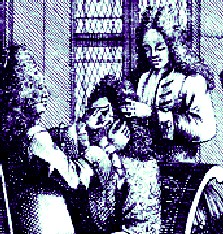
Eye Treatment, From A General System of
Surgery, By Lorenz Heister, Plate 17 (1750)
...if we cannot prevail by ...prescribed medicines fit to stay the defluxion [flows of humors], then it remains, that we apply a Seton to the neck; for it is a singular remedy against inveterate defluxions into the eyes. For we know by dayly experience, that many who have had their sight dulled by a long and great defluxion, so that they were almost blind, have by little and little recovered their former splendor and sharpness of sight, when matter once begun to be evacuated by the Seton.”1
In his case study of 'Paul the Italian Goldsmith', Paré details how he used a seton to improve the sight of a man "when he was almost blind". Even though it was working, the goldsmith removed the seton after a year, "but [with] this way of evacuation being shut up, and the humor again beginning to flow into his eyes, so that he was [again] in danger to become blind, he called me and made me again to apply the Seton in his neck. Whereby recovering his former soundness and perfection of sight, he yet wears the Seton.”2
Paré notes that, in addition to medicines, cupping and 'frictions' (rubbing of the skin to help circulate humors), setons in the neck were useful in "Inflammations, blear or blood-shot eies, and at length also Strabismus [lazy eye] or squinting"3.
Richard Wiseman also suggested seton use in troubles with the eye in addition to other humoral treatments. For patients with ophthalmia, an inflammation of the eye, he advised surgeons to "bleed by Lancet in the Arm, Neck, &c. otherwise by Leeches behind the Ears, Shaving the Head, Blistering, Cupping, Fontanels and Setons are [also] of frequent use"4. Military surgeon James Cooke suggested the use fontanels in treating cataracts. He recommends "Vesicatories [medicines to cause blistering] to the Neck, kept long open. lssues there or between the Scapula's [shoulder blades] are good; but a Seton is best."5
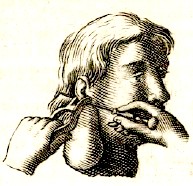
Cauterizing the Ear For a Seton,
From
L'Arcenal de
Chiurgery,
By Johannes Scultetus, p. 152 (1665)
Period authors often employed fontanels in opthalmia [swelling of the eye caused by infection]. Sea surgeon John Moyle prescribes a seton in the neck for opthalmia, as well as calling for medicines, blistering behind the ears and between the shoulder blades, bloodletting and purging medicines, all of which will "will carry forth that hot and cholerick humour that thus afflicts the eyes"6.
In his treatment of ophthalmia, Wiseman notes that fontanels sometimes resulted in unwanted swelling, but rather than forgo their use,
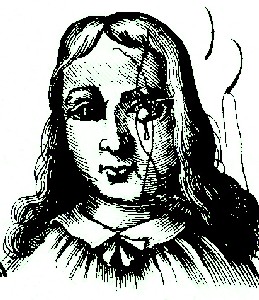
Eye Tumor Seton,
From
Armamentarum
Chirurgicum Bipartum,
By Johannes Scultetus, p. 59 (1666)
he suggested placing the fontanel in the ear.
He records two cases where this is performed. In the first, physicians placed a fontanel behind the ear of a man with sore eyes and 'blearedness covered with small white branny Scales"7. In the second, a woman with inflamed eyes and a pustule in her left eye had fontanels "made under her Ears"8.
James Cooke also supports them, explaining that "In the Ears, [a seton] 'tis admirable, for pain in the Teeth, and sore Eyes"9.
Perhaps the most extraordinary use of a seton for the eyes was in the treatment of ulcers or tumors on the eyelids. Military surgeon James Cooke advised that "A Seton is here excellent"10.
Cooke goes on to explain that while a chalazion - a tumor of the eye lid which he calls a 'Grando' - can be treated with medicines, some surgeons preferred to "draw a Thread thorow [through the tumor], and continue it as a Seton."11 That's got to hurt.
1,2 Ambroise Paré, The Workes of that Famous Chirurgion Ambrose Parey, p. 292; 2 Paré, p. 405; 4 Richard Wiseman, Eight Chirurgicall Treatises, 3rd Edition, p. 308; 5 James Cooke, Mellificium Chirurgiae, 1704, p. 139; 6 John Moyle, The Sea Chirurgeon, p. 246-7; 7 Wiseman, p. 315-6; 8 Wiseman, p. 314; 9 Cooke, p. 142; 10 Cooke, p. 90; 11 Cooke, p. 153
Health Problems Requiring a Fontanel: Head Wounds
"In all Hurts of the Head, what sort soever they be of, the Body is to be emptied; and the rather, if there be Plethora or Cacochymia: for in such Habits of body Humours are more apt to stir up ill Symptoms. Therefore you ought timely to let them blood in the Neck or Arm on the same side; and repeat Bleeding according to the exigency [need], and the strength of the Patient's body. Also Cupping (with or without Scarification) of the Neck and Shoulders, with Fontanels under the Ears, is necessary. Then lenient Purgatives [emetics], such as may evacuate the serous bloud, which by reason of its tenuity and heat readily flies to the affected Part." (Richard Wiseman, Of Wounds, Severall Chirurgicall Treatises, p. 384)
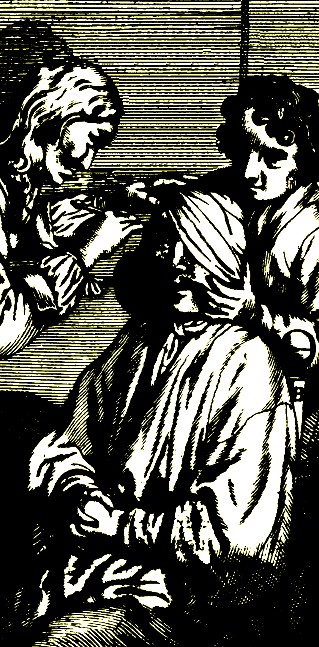
Checking a Head Wound,
From
Armamentarum Chirurgiae
Appendix,
By Johannes Scultetus, p. 188 (1671)
Directly related to problems of the eyes are wounds of the head. Here again we see multiple humoral treatments being used. Here, as Wiseman's quote shows, fontanels were just one of the many humoral treatments.
For a fractured skull, sea surgeon John Atkins explains that "Errhines [medicines used to cause nasal discharge] used to force from the Brain and sinus frontalist [sinus membranes located above the eyes], where Deparations are lodged; would with Shaving [the head], Spirituous [pure] Embrocations, a soluble [loose and opening] Diet, Issues, Setons, &c. work with more Success for the Patient, than Trepanning [boring a hole in the skull to relieve pressure]"1. Atkins trots out a variety of humoral treatments here (with errhines being one of the more curious ways to eject unwanted fluids.)
In a similar way, Atkins suggested the use of bloodletting, enemas, emetic purges and fontanels when head wounds are accompanied by "Dulness, Slumberings, and Stupidity [in head wounds], often seen at receiving Fractures"2. He believed that these methods would "derive the extravasated [forced out] Blood from the Brain, carrying it off by the Emunctories [excretive organs] and Bowels... or [would] fix an Abscess [referring to a fontanel] on some less principal Part."3
Atkins shows how he uses these multiple humoral treatments while treating a delirious sailor who had sustained a head wound. He let him blood "every Day for a Week, sometimes in the Jugular, and sometimes in the Arm, or Foot; and had a Fontanel cut inter Scapulas [between the shoulder blades]."4
In another of Atkin's cases a 'young Lad' received a concussion by his head being
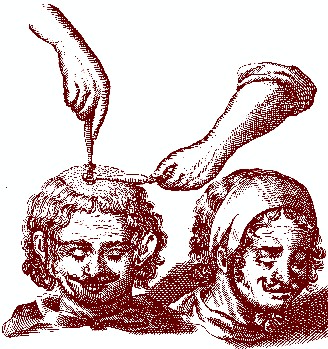
The Head Fontanel,
From
Armamentarum
Chirurgicum,
By Johannes Scultetus (1656)
knocked against boat's seat which resulted in bleeding "at the Ears and Nose, and kept doing so by Intervals for twenty-four hours; Speechless also, and insensible"5. The boy was bled several times, his temples and nostrils rubbed with spirit of lavender and volatile oil and blistering medicine were applied to his neck. "We daily after this, found some Progression in the Recovery; but the Stupidity wearing off slowly, I cut him an Issue, and left him to the Use of Errhines [substances that promote running at the nose], and have Reason to think they were of no small Benefit."6
Richard Wiseman describes the treatment of a patient with a head wound where he likewise utilized blistering of the neck and shoulders, cupping with scarification (making small incisions in the skin where the cup was placed to allow it to draw blood), fontanels behind the ears and various medicines. While not entirely successful, Wiseman reported that "by these and frequent Purging [use of emetic medicine], after a month or six weeks, he was so well as to get abroad, but was indisposed in his Head.”7
1 John Atkins, The Navy Surgeon, p. 82; 2 Atkins, p. 83; 3 Atkins, p. 84; 4 Atkins, p. 89; 5 Atkins, p. 92; 6 Atkins, p. 93; 7 Richard Wiseman, Eight Chirurgicall Treatises, 3rd Edition, p. 382
Health Problems Requiring a Fontanel: Abscesses and Infected Ulcers
Abscesses and infected ulcers both contain infected matter which had to be removed. The creation of a fontanel from such a wound seems a natural step. Richard Wiseman explained that these wounds "must be laid open proportionably, that the Matter may not be retained, and render the Wound more hollow." He suggests opening such wounds using "Caustick, then Knife; or by a Seton-needle with a twisted Silk or Thread... and proceed accordingly."1
Abscesses provided rich opportunities for using fontanels according to the
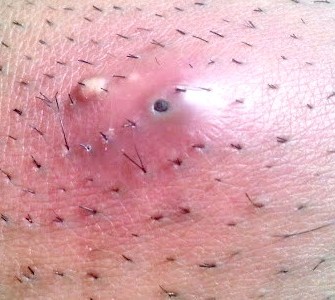
Photo: Amrith Raj - Five Day Dld Abscess
period literature. While treating an abscess of the Os Sacrum, sea physician Hugh Ryder advised a patient to let the wound function as an issue, by using "little pieces of Sponge dipt in an Emplastick [plaster] matter, which I prepared for him, for purpose to keep it open as a Fontanel, which he did for many Months"2.
Ryder explains that the patient later "fell into a most violent Feaver, from whence he was recovered by a large torrent of humours, finding vent at the Orifice [made by fontanel] so kept open; which extreamly running, in about a Fortnights time made a total discharge of the Morbifick [unhealthy] matter"3.
When confronted with a large abscess resulting from a gunshot wound, Richard Wiseman inserted a cannula (tube) into it to allow the pus trapped under the skin to drain. He then used a needle to run twisted silk through the wound "and kept in the Silk [thread in] as a Seton, till I had by [the insertion of] Gentian-roots dilated the Orifice sufficiently for the discharge of Matter."4
Wiseman sometimes used fontanels when treating swollen, infected ulcers. A sailor with an inflamed rapier wound on his biceps which had been stitched by another 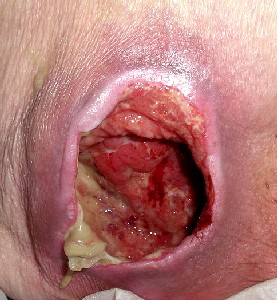
Severely Infected Skin Ulcer
doctor was brought to him. "I cut the Stitches open, and gave vent to a bloudy Sanies [serum, blood or pus], after which followed a digested Matter. ...I embrocated [rubbed it with medicine] & drest it up with Bandage to cure it. But it not yielding thereto, I passed a Seton-needle through, discharging the Matter downward; and after that Apertion [opening in the skin] was digested [softened]" after which he healed it.5
In another case, Wiseman was confronted with multiple swollen ulcers on both legs of a patient. He treated them with medicine and tight bandaging. Then, "I made him a Fontanel in each Leg and left him some Epuloticks [healing medicines] to finish it, which they effected in few days. The Issues he continued to good purpose, for he is alive to this day."6
Wiseman sometimes used fontanels in an attempt to divert humors away from inflamed ulcers. In two separate cases, each involving an inflamed ulcer in one leg, he medicated the wound to start the healing process and then created a fontanel in the opposite leg.7 The idea was to keep the humors away from the infected leg and prevent them from settling there and becoming corrupted by the wound.
1 Richard Wiseman, Eight Chirurgicall Treatises, 3rd Edition, p. 350; 2,3 Hugh Ryder, New Practical Observations in Surgery Containing Divers Remarkable Cases and Cures, p. 37-8; 4 Richard Wiseman, Of Wounds, Severall Chirurgicall Treatises, p. 416; 5 Wiseman, Eight Chirurgicall Treatises, p. 364; 6 Wiseman, Eight Chirurgicall Treatises, p. 199; 7 Wiseman, Eight Chirurgicall Treatises, p. 189 & 190;
Health Problems Requiring a Fontanel: Swelling and Tumors
Similar to abscesses were fluid-filled tumors and dropsies, where watery substances were trapped under the skin. These were treated by humoral methods including fontanels - both issues and setons.
In a case referred to by Ambroise Paré as a hydrocele ("a waterish tumor in the cod [scrotum]"), he advises "the cod and membranes wherein the water is contained, must
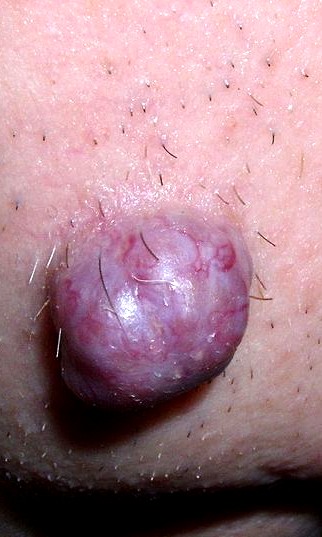
Photo: Klaus D. Peter
A Fluid Filled Tumor of the Cheek
be thrust through with a Seton, that is, with a large three-square pointed needles, thred with a skean of silk; you must thrust your needle presently through the holes of the mullets made for that purpose, not touching the substance of the Testicles. The skean of thred must be left there, for removal twice or thrice a day, that the humor may drop down, and be evacuated by little and little."1
James Cooke likewise recommends treating this problem (as well as Hydromphalos - a fluid filled tumor or cyst in the stomach) using "a Seton to [the] Scrotum"2.
Sea surgeon John Atkins suggests a different approach. "In the Sarcocele [a tumor of the testicle], we repeat Bleedings, gentle Purges [emetics], try an Issue on the Inside of the Thigh, emollient [softening] Embrocations and Fomentations, a warm Stupe wrung out of Sp. Vini [brandy], or an Emplaister [plaster]."3
Military surgeon Richard Wiseman likewise advised the use of "a Fontanel by Incision in his right Leg" of a patient with a hydrocele4, which sounds much more pleasant than the recommendations made by Paré and Cooke.
Not all cures of fluid-filled tumors and swellings were quite so wince-inducing. Wiseman discusses several cases where patients had swelling of the legs and feet. He often used fontanels in the legs for these, combined with laced stockings that would keep pressure on the swelling and cause matter to be ejected out of the fontanel wound.5
Other fluid problems were treated by such methods as well. Naval surgeon John Atkins suggested using a 'superficial Seton' when treating a tumor caused by a hernia "because the copious Discharge it makes, keeps off a Load from the vital Parts"6. Wiseman also explained that "Fontanels are also of use in the Neck and behind the Ears, &c."7 for hydrocephalus or water on the brain.
1 Ambroise Paré, The Workes of that Famous Chirurgion Ambrose Parey, p.244-5; 2 James Cooke, Mellificium Chirurgiae, 1704, p. 47; 3 John Atkins, The Navy Surgeon, p. 214; 4 Richard Wiseman, Eight Chirurgicall Treatises, 3rd Edition, p. 124; 5 For examples, see Wiseman, p. 91, & 93; 6 John Atkins, The Navy Surgeon, p. 211 7 Wiseman, p. 39
Health Problems Requiring a Fontanel: Fistulas-in-Ano
The first fontanel - a seton - had its origins in treatment of the fistula-in-ano, going back to at least the 6th century B.C.1 Hippocrates provided the procedure for this operation which was quoted in full in the Fontanel History section of this article. It was clearly an effective procedure because it is the only widely used fontanel-based procedure still in use today. The reason for this lies in the fact that Hippocrates employed a seton thread in a fistula-in-ano as way to eliminate the fistula as painlessly as possible rather than to be a focal point for removal corrupted humors.
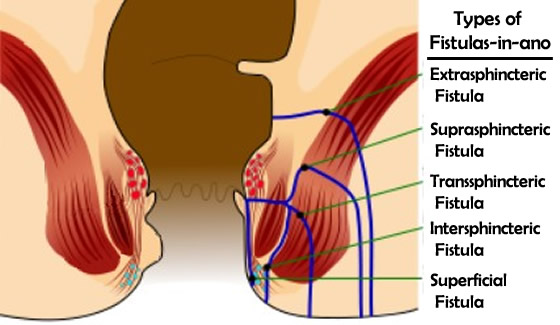
Artist: Armin Kubelbeck - Types of a Fistula-in-Ano
A fistula is an abnormal passage in the body. So a fistula-in-ano is a passage from the skin surface to the rectum or anal canal. A seton is not used as an irritant in this operation (at least not the way Hippocrates and modern authors use it); it is used to slowly cut through the wall between the fistula and the anal cavity by gradually tightening it each day. While this is being done, the seton thread also provides a way for serum and pus generated by the infection to leave the wound. (Here, it serves the same function as setons during the golden age of piracy, although we now know better than to assign an laudable properties to the pus generated by the infection. It is considered more of a necessary evil today.)
During the golden age of piracy, only one author discusses the use of setons in fistulas-in-ano: military surgeon Richard Wiseman. Wiseman's reasons for discussing setons in this infection have more to do with their potential use as long-running setons than they do with curing the fistula. Wiseman doesn't even open such fistulas using a seton thread; when he wanted to open a fistula-in-ano, he used probe scissors.2
However, Wiseman sometimes recommended that his patients keep the fistula as a way to drain off unwanted humors. In one case, he and the patient's physician "considered the Patients ill Habit of Body, and the advantage he might receive in keeping the Ulcer open as a Fontanel for the discharge of peccant [disease-causing] Humours."3 An 'ill Habit of Body' was one "proceeding from a bad Disposition of the Fluids and Humours"4. Wiseman suggests using fistulas-in-ano for this reason in several case studies5, which may explain why he includes setons in treating fistulas-in-ano at a time when few other authors were doing so.
1 "Sushruta Samhita", wikipedia, gathered 3/8/15; 2 Richard Wiseman, Eight Chirurgicall Treatises, 3rd Edition, p. 224; 3 Wiseman, p. 226; 4 John Harris, "Cachexy", Lexicon Technicum: Or, An Universal English Dictionary Of Arts And Sciences, 1725, not paginated; 5 See Wiseman, p. 226-8
Health Problems Requiring a Fontanel: Convulsive Twitching
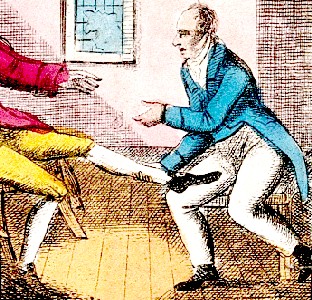
From the Wellcome Collection
Richard Wiseman also advised the use of setons in convulsive twitching cases. He is the only one to do so, although, in fairness, he is also one of the few authors to talk about treating this problem.
Two of his patients had problems with convulsive twitching in their legs, both reporting that it occurred in their lower leg. One had twitching in "the lower part of the Calf of the leg"1 and the other "on the out-side of the Os tibiae near the Shin"2. In both cases, Wiseman created a fontanel (most likely an issue, although he doesn't specify this) at the location where the twitching first began. This appeared to solve the problem.
From this Wiseman deduced that creating a fontanel at the origin eliminated twitching. He goes on to explain that he used this method in other cases such as where he "made a Fontanel between the Thumb and Fore-fingers [of one patient]; and in another [patient] in the Breast; and in a Child behind the Ear: those Fits beginning there."3
1,2,3 Richard Wiseman, Eight Chirurgicall Treatises, 3rd Edition, p. 49
Health Problems Requiring a Fontanel: Wasting Syndrome
Wasting syndrome occurs when debilitating diseases cause muscle and fat to waste away. This was often associated with luxations (dislocations). In such circumstances, Richard Wiseman employed various methods of cure, explaining that wasting muscles "requireth good drying [elimination of moist humors] and corroborating Fomentations [bathing with strengthening medicines], Emplasters [plasters], Epispasticks [blistering agents], Fontanels, &c."1
In a case involving a shoulder dislocation, his patient's
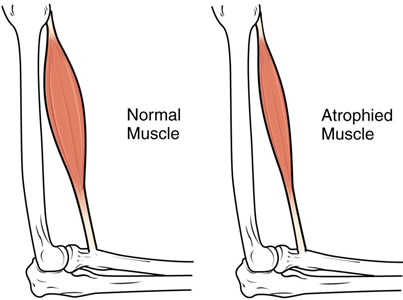
Image: Openstax College - Normal vs. Atrophied Arm Muscles
"Arm grew weaker, and emaciated very much, and was painful about the insertion of the Muscle Deltoïdes, and so to her Hand, with a nummedness in some of her Fingers."2 Wiseman first made sure the shoulder was set properly, then "Antiparalyticks [medicines] were prescribed, a Fontanel was made in that Arm near the Muscle Deltoïdes, also Embrocations [rubbing the arm with lotions and ointments] and Plaisters were externally applied; whereby she recovered the use of her Arm."3
Another case involved a luxated shoulder which eventually made the arm unable to move. Wiseman created a support for the shoulder and then "placed a Fontanel in that Arm, and rowled up the other Arm from the Hand to the Shoulder, and braced it to his Breast, designing thereby to force Nourishment into the lame Arm, and necessitate him to use it."4
In still another case, a patient experienced "a stifness of the Joints of the Wrist and Fingers, and the Arm was extreamly emaciated."5 Wiseman "made a Fontanel in that Arm; and in order to the relaxation of the stiffness of the Joynts of his Hand, I fomented them with emolient [softening] Herbs boiled in Flesh-broth, and embrocated [rubbed and massaged] them daily with ol. lumbricor [oil of earthworms]: applying a Cerote [wax] of unguent. dialthaeae and Wax over all. His Hand was also sometimes put into Grains or a Beast's Belly."6 (Here it's possible the patient started exercising and regained full use of the arm just to avoid having his hand put into 'a Beast's Belly.')
1 Richard Wiseman, Eight Chirurgicall Treatises, 3rd Edition, p. 495; 2,3 Wiseman,p. 489; 4 Wiseman,p. 491; 5,6 Wiseman,p. 84

